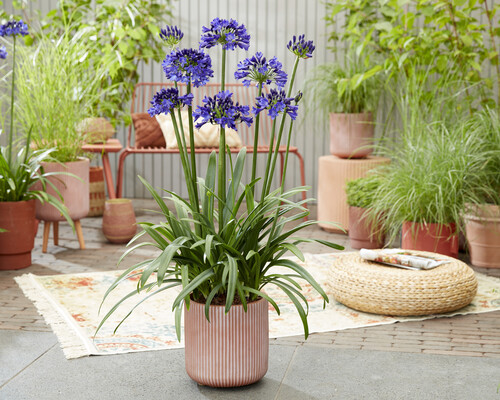Agapanthus Care Tips for Lush and Vibrant Flowers
Wiki Article
Releasing the Secret to Effective Agapanthus Growing: Tips and Tricks for a Flourishing Garden
In the world of gardening, growing agapanthus efficiently needs a critical approach that incorporates various aspects of plant care. By recognizing the nuances of agapanthus growing, one can develop an environment where these plants grow and bloom abundantly.Growing Agapanthus: Ideal Practices
When planting Agapanthus, appropriate dirt prep work is essential for making sure successful growth and advancement of these gorgeous flowers. Agapanthus, frequently called Lily of the Nile or African lily, flourishes in well-draining soil with a somewhat acidic to neutral pH degree - Agapanthus. Prior to growing, it is critical to amend hefty clay dirts with organic matter such as compost or peat moss to enhance drain and offer necessary nutrients for the plantsTo grow Agapanthus, pick an area that obtains full sunlight to partial color, as this will promote healthy growth and abundant flowering. Dig a hole twice the diameter of the plant's root sphere and put the Agapanthus at the exact same deepness it was previously growing. Delicately backfill the opening with dirt, weighing down securely to remove any air pockets around the origins.
Water the freshly grown Agapanthus completely and continue to keep the soil equally wet, particularly during the plant's active growing season. Agapanthus. Applying a balanced fertilizer once a month can further support the plant's growth and blooming. By following these best techniques for growing Agapanthus, you can create a sensational display of these fascinating blossoms in your garden
Ideal Dirt Issues for Agapanthus
For ideal growth and flowering success of Agapanthus plants, ensuring the soil problems are optimal is crucial. Agapanthus chooses soil that is abundant in nutrients, so incorporating a well balanced fertilizer throughout the growing season can promote healthy development and vibrant blooms.
Watering and Feeding Tips
To ensure healthy and balanced growth and dynamic flowers, correct watering and feeding methods are essential for effective Agapanthus farming. Agapanthus plants gain from routine watering, particularly during the growing season. It is recommended to water deeply as soon as a week, making sure the dirt is damp yet not soaked. During heat or in pots, more constant watering may be required to stop the dirt from drying out totally.When it concerns feeding Agapanthus, a official site balanced fertilizer with equivalent components nitrogen, phosphorus, and potassium can be applied in the spring to promote healthy and balanced development and flowering. Slow-release fertilizers are excellent for providing nutrients slowly over an extensive period. Avoid over-fertilizing, as this can lead to extreme vegetation development at the cost of blossoms.
Furthermore, including natural issue like compost into the soil can enhance nutrient levels and boost dirt structure, aiding in the overall health and wellness of the Agapanthus plants. By following these watering and fertilizing pointers, gardeners can ensure their Agapanthus plants prosper and produce magnificent display screens of flowers.
Trimming and Deadheading Methods
Proper trimming and deadheading strategies play an important duty in maintaining the health and wellness and aesthetics of Agapanthus plants, matching the necessary techniques of watering and feeding for effective growing. Trimming Agapanthus includes getting rid of invested flower heads, dead or yellowing leaves, and total shaping of the plant to promote far better growth. Deadheading, the process of getting rid of discolored flowers, not only improves the plant's look yet also motivates further flowering.When deadheading Agapanthus, it is advisable to clip off the flower next stem at the base using sharp, clean shears. This procedure reroutes the plant's power from seed manufacturing back right into root and foliage development, advertising a much healthier and extra durable plant. Routine deadheading can prolong the growing duration of Agapanthus and avoid self-seeding, which can cause congestion.
In terms of pruning, Agapanthus usually benefits from a light trim after flowering to clean up the plant and urge fresh growth. Reducing back the invested flower stems and removing any type of dead or broken vegetation helps preserve the plant's vigor and general appearance. Nevertheless, it is important to avoid cutting into the crown of the plant, as this can deteriorate its wellness.

Protecting Agapanthus From Pests and Diseases
Carrying out effective insect and disease administration approaches is critical to securing the health and wellness and vitality of Agapanthus plants in growing. One typical pest that influences Agapanthus is the Agapanthus borer, a caterpillar that passages right into the plant, causing damages to the blossoms and fallen leaves.In enhancement to insects, Agapanthus are prone to diseases such as origin rot and fungal fallen leave places. By staying watchful and dealing with pest and disease issues immediately, garden enthusiasts can assist their Agapanthus thrive and grow.

Final Thought
Finally, effective cultivation of agapanthus needs appropriate planting techniques, ideal soil conditions, adequate watering and fertilizing, routine pruning and deadheading, and protection from illness and pests. By following these methods and pointers, garden enthusiasts can make sure a growing garden full of attractive agapanthus flowers. Agapanthus. Bear in mind to keep regular treatment and interest to detail to advertise the health and wellness and durability of these magnificent plantsWhen planting Agapanthus, correct soil prep work is important for making certain successful growth and advancement of these gorgeous flowers.Water the newly grown Agapanthus completely and continue to keep the dirt evenly wet, specifically during the plant's energetic growing period.For optimum growth and flowering success of Agapanthus plants, making certain the dirt problems are optimal is essential. When transplanting or growing Agapanthus, ensure the soil is well-prepared to provide the needed foundation for the plants to establish themselves why not look here successfully. One usual pest that influences Agapanthus is the Agapanthus borer, a caterpillar that tunnels right into the plant, triggering damage to the fallen leaves and blossoms.
Report this wiki page